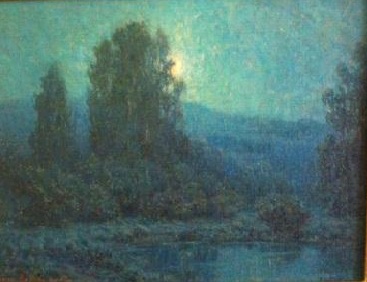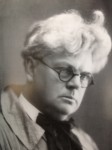
Granville Redmond
American, 1871-1935
Moonrise, n.d.
Oil on canvas
12 x 16"
Private Collection

Photograph of Granville Redmond, 1925
"It is impossible for artists to succeed in art unless they work with thought and true insight…one must as he paints on a canvas try and put his soul into the work." - Granville Redmond

Photograph of Granville Redmond in his studio, n.d.
COMMENTS
Granville Redmond may be seen as a transitional figure among California landscape painters of the early twentieth century. His quiet scenes of the coastal countryside formed a stylistic connection between the dominant tonalist painters in Northern California, and an emerging group of plein air artists in Southern California.
Redmond, who received his art training in San Francisco and Paris, painted in a distinctive personal style inspired by French Barbizon and Impressionist exemplars. Influences from California painters such as William Keith and Arthur Mathews, and the impact of such great American artists as George Inness and James McNeill Whistler can be recognized in Redmond's mature work.
Redmond's subtle evocation of specific atmoospheric conditions in the landscape transformed the ordinary. His skies were spectacular. They set the tone of the paintings, carrying the essential illumination that established the mood, expressing best the poetry he saw in nature. The quality of light captured by his distinctive applications of pigment gave full account of a wide range of atmospheric conditions that are typical of coastal California. Morning mist, marine fog, afternoon haze, or the breezy clarity of a summer sky were each conveyed with convincing accuracy, and an artistry that transcended technique. Redmond illuminated his scenes with a theatrical flair for lighting that would be the envy of a Broadway or Hollywood lighting director. His moonlit seascapes, sunset beaches and brilliant midday fields of wildflowers attest to his accute powers of observation regarding the transmittal of light from various sources. The dramatic depiiction of reflections and shadows further enhance his carefully constructed compositions. The fleeting moments of some particular quality of light are observed and retained in the memory of the artist and then later recalled and applied with impressive consistency to a painting that could not have been completely executed "en plein air." As was common prectice among many plein air painters who were inspired by Impressionist techniques, Redmond necessarily executed his major canvases in the studio, dependent upon his vivid recollections of a scene aided by hastily sketched small studies done at the site.
Especially notable are his nocturnes and dimly lighted scenes, which because of the artist's accuracy of memory reveal pictorial truths that would elude a more casual observer.
Granville Redmond's many moonlight and moonrise subjects are examples of his inventive and somewhat playful approaches to the compositional placement of his light source. In some of the moonlit seascapes, the light reflected on the surf and radiating in the sky above comes from a moon that is "located" just above the top framing edge of his paintings. In other compositions, a full moon appears only as a reflection in a pond, the actual light source being hidden beyond the frame.
- Granville Redmond, The Oakland Art Museum, 1988
